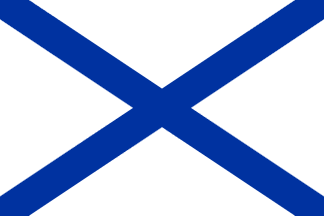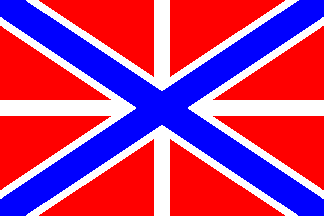 image by H B, 11 May 2012
image by H B, 11 May 2012
Last modified: 2024-11-23 by rob raeside
Keywords: navy | andreevskiĭ |
Links: FOTW homepage |
search |
disclaimer and copyright |
write us |
mirrors
 image by Zoltan Horvath, 7 September 2024
image by Zoltan Horvath, 7 September 2024
First adopted in 1712.
António Martins, 25 Oct 1999
This flag is called in Russian
"андреевский"
(read "Ahndrehyevskeey"), which means "[St.]
Andrew’s", referring to the saltire
motive.
António Martins, 11 Jun 2000
It was precisely on ships of the Russian Black Sea Fleet that
this flag was hoisted for the first time three hundred years ago
by the order of Peter the Great. The history of the Russian navy
knows not a single case when this flag was lowered as a sign of
surrender to the enemy.
Lev Ryabchikov (ITAR-TASS), 11 Dec 1999
A cute bit of phraseology! One can always twist words to make
even the greatest catastrophe sound glorious and pleasant.
In 1904-05 the Japanese destroyed most of Russia’s Pacific fleet.
The Baltic fleet then circumnavigated the globe to meet the
Japanese — only to meet the same fate. Many ships did indeed go
down with St. Andrew’s flag still flying. After that disaster, Russia
began a massive rebuilding programme.
Todd Mills, 13 Dec 1999
With all due respect to the Russian Navy, this claim strikes me as
unlikely since the Japanese Navy took several Russian warships as prizes
at the Battle of Tsushima, some of which were repaired and
recommissioned in the IJN, e.g. the
Okinoshima, ex-General Admiral Graf Apaaksin.
Tom Gregg, 13 Dec 1999
Even apart from the Tsushima debacle, I’m skeptical of this claim.
There were periods in the Napoleonic wars, if I recall correctly, when
Russia was allied with France. I’d bet that at least once in
that period a Russian man-of-war struck to a British vessel somewhere
in the world. And no surrenders during the Crimean War? World War I?
Really hard to believe.
Joe McMillan, 13 Dec 1999
I checked Fred T. Jane’s 1904 book, The Imperial Russian Navy,
just to verify my hunch that it couldn’t be true.
In his historical chapters, Jane includes examples of Russian ships
surrendering to Swedish, Austrian, and British ships. This includes
specifically the statements that the 74-gun ship of the line Vladimir
“struck” to the Swedes at Gotland in 1714 and the Svlod to
HMS Centaur in
1808. In addition, although Jane doesn’t specifically refer to striking of
colors, Admiral Senyavin surrendered his entire fleet to the Royal Navy in
the Tagus estuary in Portugal in August 1808. Since Jane was writing before
the Russo-Japanese War, this does not include the Tsushima debacle.
The current Andreyevsky flag was introduced in 1712
and remained the ensign
of the Russian Navy until 1917. There’s a remote chance, I suppose, that in
each case mentioned above (and the other surrenders of Russian vessels) it
was some other flag that was struck. Many flags
were used at varying periods up to 1865, so it may be that
there’s a bit of sophistry at play in the claim that the Andreyevsky flag
has never been lowered in surrender. But I’d say the burden of proof is on
the Russian Navy, and even if that’s their rationale it would be a pretty
flimsy case.
Joe McMillan, 16 Dec 1999
 image by Zoltan Horvath, 7 September 2024
image by Zoltan Horvath, 7 September 2024
First adopted in 1700.
António Martins, 25 Oct 1999
 Miles Li, 8 Feb 2009
Miles Li, 8 Feb 2009credits to Yosef Obskura and Željko Heimer


Maybe somebody could identify the Russian Naval Ensign with an anchor
arm in the middle, and a pennant in the lower part of the flag. The
flag was brought by the 336th Marine-Infantery Brigade of Baltijsk at
its recent visit to the Royal Swedish Amphibious Regiment of Älvsborg,
Gothenburg, Sweden.
Kristian Söderberg, 12 Jul 2005
I don't know what it's the flag of, but the orange and black ribbon
in the lower part of the flag is the emblem of a unit
designated "guards" (gvardiya), and the 336th brigade does indeed
have the guards designation. In addition, a navy blue circle
bordered in red and charged with a yellow foul anchor is the branch
insignia for naval infantry in the Russian Navy. So I'd speculate
that this might be a flag of the naval infantry collectively, or of
the 336th brigade in particular.
Joseph McMillan, 12 July 2005
 image located by William Garrison, 1 December 2020
image located by William Garrison, 1 December 2020
Source:
https://eng.mil.ru/en/structure/forces/navy/news/more.htm?id=12316142@egNews
In the link above, Russian and Iranian sailors held a joint sea search and
rescue exercise during the maneuvers "Kavkaz-2020"
As part of the
maneuvers "Kavkaz-2020", a detachment of emergency rescue vessels of the
[Russian] Caspian flotilla and ships of the Navy of the Islamic Republic of Iran
performed joint actions to assist a surface ship that was conditionally damaged
in combat, search and rescue of the crew in the water.
The exercise was
attended by the rescue tug ship SB-738, the raid diving boats of the project
23040 RVC-946 and RVC-933, and the Iranian Navy's "Paykan" missile ship acted as
an emergency object.
William Garrison, 1 December 2020